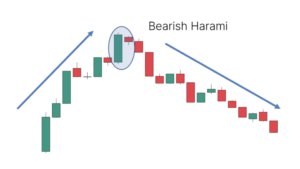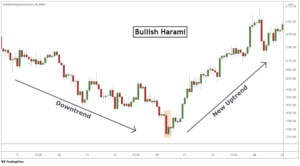What is the Harami Candlestick Pattern?
Harami is a Japanese candlestick pattern composed of two candlesticks. The first is a larger black or red body, and the second is a smaller white or green body. The pattern’s name, “Harami,” comes from the Japanese word for “pregnant,” as the graphic representation resembles a pregnant woman.
This candlestick pattern consists of two candles: the first candle is larger and the second candle is smaller and contained within the first candle. It is a potential indicator of a bullish or bearish reversal in the market.
A Harami pattern consists of two candles:
- The first candle is a large candlestick, often called the “mother” candle.
- The second, smaller candle, the “baby,” is completely engulfed by the first candle’s body.
The key here is the second candle, which opens and closes within the body of the first. This pattern suggests a potential reversal in market trends, providing traders with valuable foresight.
Bearish Harami vs Bullish Harami
The Harami pattern can signal both bullish and bearish market conditions, depending on its formation:
Bearish Harami:

- Formation: This pattern appears after an uptrend. The first candle is bullish (white or green), followed by a smaller bearish (black or red) candle.
- Interpretation: It indicates that the upward momentum is weakening, and sellers might be gaining control. This often leads to a price decline, signaling a bearish reversal.
Bullish Harami:

- Formation: This pattern occurs after a downtrend. The first candle is bearish, and the second is a smaller bullish candle.
- Interpretation: It suggests that the downward momentum is losing steam, and buyers may be stepping in. This typically results in a bullish reversal, with prices potentially rising.

Leave a Reply